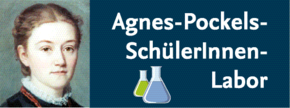
We would like to present you with some first impressions of our work with children and teenagers. The photos on this page were chosen for their visuality; we have also aimed at presenting as wide a range of activities as possible.
First of all we would like to show you the 'Agnes-Pockels-Laboratory' which was established thanks to the generous support of the Technical University of Braunschweig. Here you can see a group in the large laboratory room; behind this there is a smaller room. There is room for 32 pupils in total. There is also a seminar room and the office. Each week around 4 - 5 groups visit us. In addition, 4 workshops meet in the afternoon. Generally though, a lot of the experiments can be carried out directly in nurseries and schools.
Our experiment kits play an essential part in 'exporting' chemical trials. They contain all the materials required for particular topics and in this way complement the experiment instructions in a practical way. - Pupils at the Bürgerstraße junior school (Braunschweig) examine soil samples.
Protective and safety measures and the corresponding equipment for the children is always discussed at the beginning of an experimenting unit. Our photo shows another important approach to this topic: hazard labels which sharpen awareness for hazardous substance classes. Such warnings can also be found on household chemicals and can therefore be researched by the children themselves. Comeniusstraße junior school (Braunschweig).
Nursery children visit our laboratory too. This experiment series is called 'Science with children'. Our photos show an experiment sequence with red cabbage juice which ends up as quite a colourful range of fluids. In another experiment we use apples to investigate the effects of vitamin C.
Chemical experiments - science or magic? In our 'Chemistry and Magic' scheme we focus initially on some quite surprising effects. Subsequent experiments help to find a scientific explanation. Both photos show experiments with invisible inks. Further examples can be seen below under further training for teachers.
Our main aim is to stimulate curiosity and interest and to get the children asking constructive questions; the children can practice this particularly well in the 'Early Learning Workshop'. The children are recommended for the workshop by junior schools in Braunschweig.
Visit to the university laboratory. Pupils from year 7 and 8 at a secondary school in Wolfenbüttel take part in "Tracing the culprit" (our most established, very successful scheme). The children are examining confiscated clothing. The question is: which stains are blood and which are not? Chemical evidence will be produced.
'Air and Combustion', tailored to pupils from year 9 to 11. This includes examining cigarette smoke and car exhausts for pollutants. The bag in the picture is filled by a normal car exhaust pipe.
Evidence of CO2, CO and NOx .
Evidence of salts in food - a project for year 11 and 12. The picture on the left is an experiment about chloride in parsley. The two school girls on the right are pleased at having found evidence of iron ions.
School girls at the Lessing secondary school in Braunschweig analyse colouring. After extracting colour from M&Ms, the amount of brilliant blue colour in the glaze is determined by photometric means. In addition, a kinetic examination is carried out.
We also offer further training for teachers and nursery nurses which we carry out periodically and on request. Here the 'Chemistry and Magic' project is shown. The photos on the left: magic porridge (above), the pharaoh's snake (below).
And finally we would like you to know that we also help Miss Marple in solving difficult cases. In this special crime case the two professors, Mischnick and Felser, are in charge of the chemical evidence. Several hundred children are captured by what is happening ('Children's Uni' in autumn 2004).